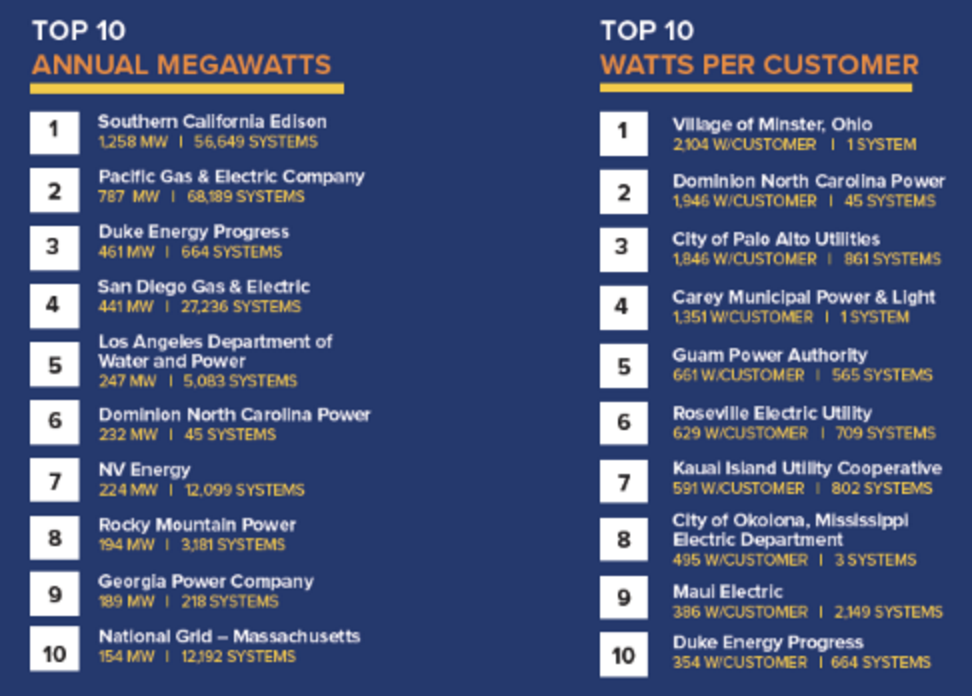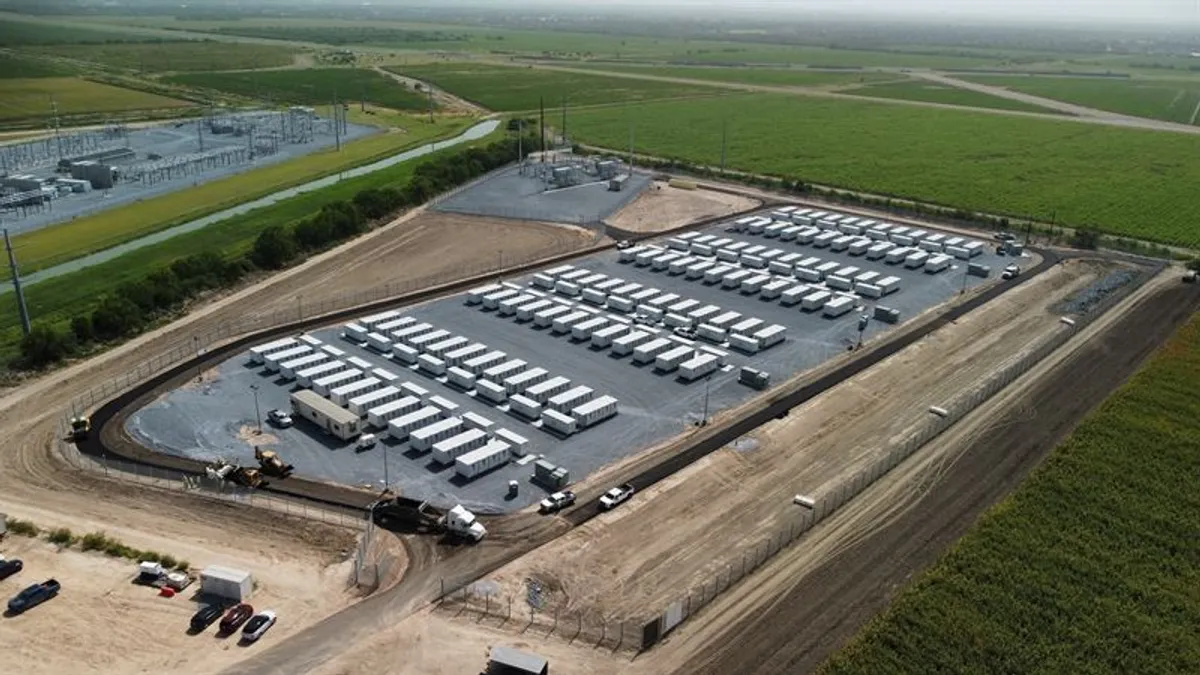Utility-scale solar boomed in 2015, deploying a record-setting 4 GW of capacity throughout the year, over half of the 7.3 GW of solar that came online.
That growth is expected to continue into the 2020s, especially after the extension of the 30% investment tax credit for solar at the end of the year. As the market continues to blossom, the Smart Electric Power Alliance (SEPA) recognized ten major utilities in their latest survey that installed the most utility solar capacity last year.
SEPA offers two lists of top ten utilities for 2015: One for total installed solar capacity and one for installed watts of solar per customer. The lists are “a benchmark” for other utilities to reach, said SEPA research analyst Ryan Edge, and reflected trends shaping the transformation of the utility sector. Policies and declining costs have historically been major drivers of solar deployment, and it appears that it was no different for utilities in 2015.

SCE takes top slot
Southern California Edison (SCE) appeared to hit the sweet spot of favorable policies and declining costs as the investor-owned utility took the No. 1 spot on the list of overall solar deployment, knocking out fellow California IOU Pacific Gas and Electric for the first time in the six years since SEPA has done the survey.
SCE’s first place finish “is the result of the work that SCE has been engaged in for many years, not just in connecting solar, but in supporting California’s ambitious carbon reduction goals and supporting customer choice,” said Caroline Choi, vice president of Energy and Environmental Policy said in a statement.
So far, SCE can claim a record 1,258 MW of installed solar capacity — spurred in part by the fact that it must meet California’s 50% renewable energy mandate by 2030. Additionally, the utility says it is incorporating more energy storage while studying how to integrate and manage distributed energy resources.

PURPA driving growth
Policy-wise, the major driver for three IOUs on the list was the Public Utility Regulatory Policies Act (PURPA). Duke Energy, Dominion North Carolina Power, and Rocky Mountain power — listed 3rd, 6th and 8th, respectively on the overall solar list — and 8 respectively, can point to this federal policy as a major driver in their growth, SEPA’s Edge told Utility Dive.
The growth of all three was driven “because of how much PURPA is pushing the market,” Edge said. “North Carolina doesn’t have third party ownership or other drivers for growth on the customer side of the meter, but they do have PURPA and the way they calculate avoided cost in North Carolina enables PURPA qualifying facilities.”
The law, first passed in 1978, was crafted in response to oil shortages that drove unprecedented power price spikes during that decade. At its base, PURPA ensures utilities diversify their power mix, compelling them to purchase power from qualifying third party providers at or below their avoided cost rate for generation. States set size limits for projects and sign off on contracts.
In North Carolina and Utah, developers have discovered how to make PURPA’s standard contract offer work as successfully as a power purchase agreement, Edge said. “Strata Solar is the North Carolina developer that figured out how to make PURPA work there.”
Only projects of 5 MW or less are eligible for PURPA contracts in North Carolina, said Brian O’Hara, senior vice president of government affairs and strategy at Strata. Making them work “was a matter of figuring out the finance structure and having the gumption to take the risk.”
Early on, a state tax credit and the federal ITC were in place, O’Hara said. “Now there is no state tax credit but the price of solar is low enough to keep the market going.”
North Carolina’s retail rate is about $0.12/kWh, with the avoided cost at $0.06/kWh. That offers a better opportunity for solar than in other states because it is based on the marginal cost of energy from a natural gas plant that includes both energy and capacity components, O’Hara said.
Market forces like the price of natural gas have driven the state’s avoided cost down over time, but solar cost reductions have kept pace so Strata can still make a project viable, he said. And, because the utilities are buying at their avoided cost, solar does not put upward pressure on rates.
But along with that deployment success comes challenges.
“It is getting harder because there are so many more players and the interconnection queues are so filled out,” O’Hara said.
Utilities have begun to realize 50 MW installations can offer economies of scale not available from 5 MW projects, he added. “To keep growth going, the problem of the size of the interconnection queue needs to be addressed and larger projects will help do that.”

Growth on both sides of the meter
Other factors behind the rankings include state solar incentive policies, the investment tax credit and a push among utilities for a more diversified power mix. National Grid, a major utility in the Northeast, fell from fifth place to tenth as its overall growth in solar fell. However, its Massachusetts’ arm saw its total installed capacity go up from 124 MW in 2014 to 154 MW in 2015. The growth didn’t come from utility-scale solar, but from behind-the-meter solar stemming from the state’s net metering and Solar Renewable Energy Credit policies (SREC), as well as momentum from the solar market, Edge said.
The federal investment tax credit (ITC) may also been a factor, he added. Installers scrambled to make sales ahead of an anticipated drop in its value until it was extended in December.
The looming cap on net metering, which significantly slowed 2016 solar growth until it was extended last month, also pushed installers, Edge said.
For Georgia Power, which was named IOU of the Year by SEPA in 2014 and ranks just ahead of National Grid in ninth place in this year’s list, different factors played into its solar growth.
The Southern Co. subsidiary saw its 2015 growth almost entirely in utility-scale and C&I scale solar, which wasn’t driven by renewables mandate, or PURPA contracts. Furthermore, its behind-the-meter policies were only available part of the year, Edge said.
A Georgia Power spokesman said the utility wants a diversified generation mix that includes renewables, and, as solar becomes more economical, recognizing the demand for solar from regulators and its customer base.
“Solar is a cost-effective way to diversify our energy portfolio without putting upward pressure on rates,” Spokesman John Kraft added.
Georgia Power expects to have 1 GW of solar capacity online by the end of this year, with about 166 MW coming from installations built in partnerships with the military through direct ownership or power purchase agreements.
The partnership emerged as the utility became aware Department of Defense directives put the state’s military installations in the market for renewables.
“The military is an important customer for us and we want to be responsive to what they are interested in,” Kraft said.
Other utilities in the Southeast, led by other Southern Co. subsidiaries, are starting to see what Georgia Power sees, Strata’s O’Hara said.
“Southern Company sees the future, understands it definitely includes solar, and understands how solar can benefit the utility,” he said.
Customer demand is driving “a push into solar in Alabama,” O’Hara said. “Strata is building two solar farms for Southern Company subsidiary Alabama Power at army facilities in the state and new solar RFPs will be forthcoming.”
Strata is also building a project for Southern Company subsidiary Mississippi Power. The drivers there, O’Hara said, are the utility’s intent to diversify it resource mix and hedge against natural gas price increases.
“Once Alabama and Mississippi have some experience with utility-scale solar, the attractive economics for both ratepayers and the utilities will drive further growth like we're seeing in Georgia,” O’Hara said.
Future growth areas
Two key findings from SEPA’s survey shed some light on potential future growth sectors for utility solar.
At least 85 utilities of 190 currently have a community solar program and, more significantly, two-thirds of those 190 respondents said they are researching or planning their own community solar programs, Edge said.
“Utilities have a competitive advantage against other developers in reaching a market the solar industry doesn’t normally get to,” Edge pointed out. Community solar can fill a gap in the market for customers who rent homes, don’t have suitable roofs or lack financial resources to own or lease solar.
The other key finding should come as no surprise: net metering reforms. Eighty-three of the respondents said they are implementing, researching or interested in such reforms.
Below a certain level of grid penetration by solar, any cost associated with net metering is immaterial, he said. “But we are starting to get to penetrations in some places where utilities are starting to address it.”
Ultimately, it’s clear utilities are not backing away from solar anytime soon.
Changes to NEM that compromise the solar value proposition would affect the residential solar sector most. It could also drive more utility customers to community solar.
In assimilating the survey data, Edge said, he was struck by how much the market is now outside the Southwest.
“The East Coast is now well represented. States like Utah, Colorado, and Texas now have between 200 MW and 999 MW of solar. Indiana and Tennessee have between 50 MW and 199 MW,” he said. “That is a sign of solar becoming more the norm.”




















